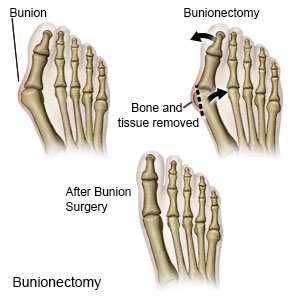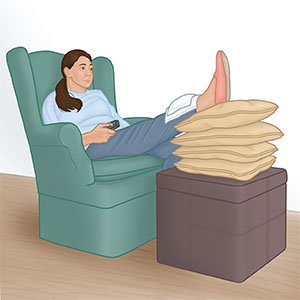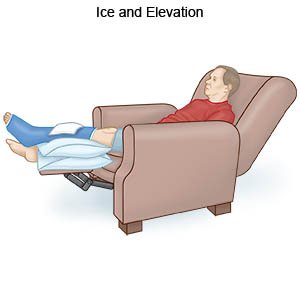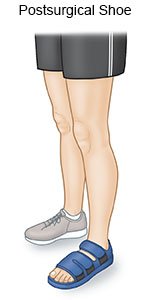Bunionectomy
Medically reviewed by Drugs.com. Last updated on Aug 4, 2025.
AMBULATORY CARE:
What you need to know about bunionectomy:
A bunionectomy is surgery to remove the bunion and bring your big toe back into its correct position. Bones, tendons, nerves, or ligaments may also be moved or put into the correct position.
 |
How to prepare for bunionectomy:
Your healthcare provider will talk to you about how to prepare for surgery. He or she may tell you not to eat or drink anything after midnight on the day of your surgery. He or she will tell you what medicines to take or not take on the day of your surgery. You may be given an antibiotic through your IV to help prevent a bacterial infection. Arrange for someone to drive you home and stay with you to make sure you are okay.
What will happen during bunionectomy:
- You may get anesthesia to numb your foot or numb your leg from the knee down. You may instead get spinal anesthesia to numb you below the waist. With these types of anesthesia, you may feel pressure or pushing, but you should not feel any pain. General anesthesia is sometimes used to keep you completely asleep.
- Your surgeon will make an incision on the top, side of, or below the bunion. You may need more than 1 incision. Extra bone and tissue may be removed. Your surgeon may make small cuts in the bones to place the bones in the correct position. He or she may instead remove the bunion and line up the bones. The ligament (strong tissue) that has tightened and pulled the toe inward may be cut to help make the toe straight again. In some cases, you may need to have your toe joint rebuilt or repaired. Pins, screws, wires, or plates may be placed in your toe joint to hold it in place. The incision is then closed with stitches and covered with a bandage.
What will happen after bunionectomy:
You will usually be able to go home after bunionectomy. You may have a toe spacer to hold your toe in place for up to 6 weeks while your foot heals. You may need to wear a post surgical shoe for up to 6 weeks after surgery. You may need crutches or a walker if you cannot put weight on your foot. You may have a brace or cast while your toe heals.
Risks of bunionectomy:
- You may bleed more than expected or get an infection. The nerves in your foot may be damaged during surgery. You may continue to have pain. You may have stiffness in your toe joint and your big toe may not line up with your other toes. Your bones may not fully heal. Your bunion may return. You may get a blood clot in your leg. This may become life-threatening.
- It may take up to 6 months to return to your usual activities. Your foot may have some swelling for up to 1 year after bunionectomy. You may not be able to wear heels or small or narrow pointed shoes again.
Call your local emergency number (911 in the US) for any of the following:
- You feel lightheaded, short of breath, and have chest pain.
- You cough up blood.
Seek care immediately if:
- Your leg feels warm, tender, and painful. It may look swollen and red.
- Blood soaks through your bandage or drains out of your brace or cast.
- Your stitches come apart.
- Your incision is red, swollen, or draining pus.
Call your doctor or surgeon if:
- Your bandage gets wet, is loose, or comes off.
- Your pain gets worse or does not get better with pain medicine.
- You have a fever and chills.
- You have questions or concerns about your condition or care.
Medicines:
You may need any of the following:
- Prescription pain medicine may be given. Ask your healthcare provider how to take this medicine safely. Some prescription pain medicines contain acetaminophen. Do not take other medicines that contain acetaminophen without talking to your healthcare provider. Too much acetaminophen may cause liver damage. Prescription pain medicine may cause constipation. Ask your healthcare provider how to prevent or treat constipation.
- NSAIDs , such as ibuprofen, help decrease swelling, pain, and fever. NSAIDs can cause stomach bleeding or kidney problems in certain people. If you take blood thinner medicine, always ask your healthcare provider if NSAIDs are safe for you. Always read the medicine label and follow directions.
- Antibiotics help prevent a bacterial infection.
- Take your medicine as directed. Contact your healthcare provider if you think your medicine is not helping or if you have side effects. Tell your provider if you are allergic to any medicine. Keep a list of the medicines, vitamins, and herbs you take. Include the amounts, and when and why you take them. Bring the list or the pill bottles to follow-up visits. Carry your medicine list with you in case of an emergency.
Care for your wound as directed:
Do not remove the bandage unless your healthcare provider tells you to. The bandage helps keep your toe in the correct position while it heals. Keep your bandage and wound dry. Wrap your foot in a plastic bag before your bathe. Seal the bag as tightly as you can. Try to keep your foot out of the water.
Care for your foot:
- Elevate your foot above the level of your heart as often as you can for the first 3 days after surgery. This will help decrease swelling and pain. Prop your foot on pillows or blankets to keep it elevated comfortably.

- Apply ice on your foot or cast for 15 to 20 minutes every hour or as directed. Use an ice pack, or put crushed ice in a plastic bag. Cover it with a towel. Ice helps prevent tissue damage and decreases swelling and pain.

Activity:
You may need to limit activity for the first 3 days after surgery. Ask your healthcare provider when you can safely be active. Activity will help prevent a blood clot. The following can help protect your toe and surgery wound until you heal:
- Wear a post surgical shoe for 2 to 6 weeks or as directed. This shoe helps keep your foot and toes in a stable position to help you heal faster. It also protects your toe from injury.

- Use crutches or a walker as directed if you cannot put any weight on your foot. You may have a brace or cast to hold the position of your foot while it heals.
Go to physical therapy if directed:
A physical therapist teaches you exercises to help improve movement and strength, and to decrease pain. The therapist will tell you how and when to start moving your toe. This will help prevent stiffness. Ask when you can return to your usual activities, such as driving.
Follow up with your doctor or surgeon as directed:
You may need to return in 2 or 3 weeks to have your stitches removed. You may need to wear a support bandage or brace for 6 to 12 weeks. You will need regular follow-up visits for several months to make sure your foot heals correctly. Write down your questions so you remember to ask them during your visits.
© Copyright Merative 2025 Information is for End User's use only and may not be sold, redistributed or otherwise used for commercial purposes.
The above information is an educational aid only. It is not intended as medical advice for individual conditions or treatments. Talk to your doctor, nurse or pharmacist before following any medical regimen to see if it is safe and effective for you.
Further information
Always consult your healthcare provider to ensure the information displayed on this page applies to your personal circumstances.
